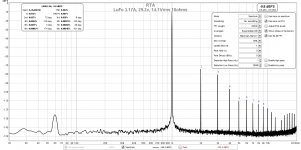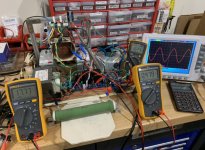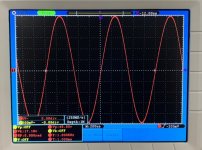Amazing - subscribed! I wonder if my Hugo TT2 (9.3Vrms at 0dB) has enough drive.
Since it’s 0dB gain, 9.3vrms gets you 11w. Good enough for most casual listening but limiting your peak output for transients.
I personally am enjoying the sound of a preamp capable of 40Vpp and also 55vpp. The pre has to do the whole voltage gain so acting as your input stage and VAS.
Great amp X!!!
you have more experience than me but maybe you try some tips by the ACA premium...
- gate stopper resistor 120R instead of 100R to avoid high freq. oscillation
- try IRFP140 instead of IRFP240
chris
Thanks, Chermann! I am specifying the IRFP240 because that’s all that is needed here as a cascode. Running 25w dissipation is nothing. You can certainly use bigger more capable MOSFETs here. I am using some Phillips PSMN020-150W’s because I have a bunch on hand. Certainly did not need the larger dissipation capability. One thing with a bigger MOSFET, is that you can use fewer of them. But the thermal load becomes very localized. I normally use a single IXTK88N30P for the full 75w (I have used them 150w continuous) but that needs a cpu cooler and a fan.
The MOSFETs here are not so critical to the sound as the JFET is the master device that controls the show.
There doesn’t appear to be any oscillation issues at 100ohms, maybe 220R would have been fine as well on a cascode gate?
Last edited:
PSMN020 in LFPAK case works well? it is dirty cheap....
What preamp do you use to make it sound like Hugh Glass Harmony ?
What preamp do you use to make it sound like Hugh Glass Harmony ?
Hi X - good work.
I have ten of these available (IRFP450);
https://www.vishay.com/docs/91233/91233.pdf
are they OK to use in you LuFo?
I have ten of these available (IRFP450);
https://www.vishay.com/docs/91233/91233.pdf
are they OK to use in you LuFo?
IRFp540 looks like a fine device for LuFo. It’s not so critical what one uses for the cascode as the LU1014D is the controlling output device. The cascode mostly acts to shield the LU from the high voltage that would normally fry it. But all the current passes through the LU1014D.
Can I use more commonly available jfet say mpf 102 and mosfet 640 or 740 with lesser rail supply 12v 2amps?
X,
Since you were comparing sound from amps, how does it compare to the Alpha Nirvana. I am thinking should sound very similar.
MM
Since you were comparing sound from amps, how does it compare to the Alpha Nirvana. I am thinking should sound very similar.
MM
Can I use more commonly available jfet say mpf 102 and mosfet 640 or 740 with lesser rail supply 12v 2amps?
Hi Indr,
I am not sure what you mean. MPF102 appears to be small signal TO92. Not suitable for being the 3A current master in a Class A cascoded output stage.
The Lu1014D or its SMT equivalent, the LD1014D are still readily available from Aliexpress or EBay, or for free from Mr Pass on the LU1014D GB. It is special in that it acts like a triode and can pass 3A or more. You can make a 12v version but the whole thing needs to be simulated. The amp as presented here has been tested and verified to work. The tricky part is the inductor. You can use a Hammond 193V or similar - circa 1ohm. Or use a 120vAC based microwave oven transformer like I did. Those have impedences in the 0.5ohm range.
To find one used in surplus market, do a search for “microwave oven transformer MD-803AMR”.
X,
Since you were comparing sound from amps, how does it compare to the Alpha Nirvana. I am thinking should sound very similar.
MM
I only have one channel and have not listened to them side by side. Hard to say other than it sounds like it’s doing all the right things.
I personally use a preamp designed by Hugh Dean, whom designed it at my request specifically to drive the F4 amp to full power (25wrms or 40 Vpp) with low distortion and be of SE Class A topology in order to have a nice harmonic profile. The layout was done by JPS64 and has superb grounding to be as quiet as possiblle. Also required was that it uses a minimal number (5) of easy to source actives (plain TO92 BJTs, a DN2540 TO-220 for a CCS and a KSA1381 TO-126 as the output driver. Finally it can be powered with a simple DCDC converter powered by a 12v wallwart AC adpater.
Please PM me if you would like more info about it.
Please PM me if you would like more info about it.
Another data point for 14.1Vrms into 10ohms - about 0.06% THD:

You can listen to a quick video of the LuFo playing through a no-name 6.5in 2-way speaker. Recorded with my phone - the sound is remarkably clear though.
Test of LuFo Amp with 6.5in 2-way Reflex - YouTube
You can listen to a quick video of the LuFo playing through a no-name 6.5in 2-way speaker. Recorded with my phone - the sound is remarkably clear though.
Test of LuFo Amp with 6.5in 2-way Reflex - YouTube
Attachments
Last edited:
Hi X,
I have a feeling that the very low noise is a very good PSRR AND a SLB regulator; you could probably run a simple CRC and it would be very quiet.
Outstanding harmonic profile, and very low THD, although H3 is a bit close to H2, a characteristic of many semis. But an excellent amp and very good measurement technique.
OK at high volumes? Should have very low congestion with busy music because there is no complicating feedback.
Hugh
X and Hugh,
Just thinking out loud here. Is there any way to improve the CCS design of this circuit, to provide even better PSRR? Is it necessary?
The nice thing I like about the SLB supply is that I specifically use it and target it for designs that have poorer PSRR (and are Class A). So that includes Aleph J, etc...these designs generally have low to moderate amounts of feedback and lower damping factors as well. I wouldn't use it in a Class AB design with .000X% distortion figures however, as it would be unnecessary.
The LUFO is a very simple design and what seems to be an augmentation of the MOFO, with a cascode CCS on the drain instead of a resistor along with the usual choke on the source end. To my feeble mind, it reminds of a power tube stage in a cathode follower configuration with a CCS on the plate. Or at least...sort of. There are lots of variants on this concept, Alan Kimmel's MU stage, parallel feed, etc....basically what designers are trying to do is to insulate the output device from the perturbations of the power supply which apparently is challenging!
Pairing it up with a very low THD gain stage would be ideal so that we can hear the LU1014D with absolute clarity.
Thanks for your thoughts!
Best,
Anand.
Hi Folks,
I am not sure if this was what you were all waiting for - is a 39w amp with a cheap salvaged choke made from a microwave oven transformer and 28v single supply possible?
The specifics are: Vsupply of 27.3vdc, voltage as LU1014D was 1.527v, bias current was 2.90A, and Vrms according to the Fluke 116 was 17.77vrms. The Oscope shows 17.77Vrms as well. That’s 39.5wrms into 8ohms - well before clipping starts. One interesting thing to note is that backing off on the bias current to 2.9A yields better clip performance than 3.0A. Not sure why, maybe combination of voltage sag on limited voltage from time of day max voltage of 27.3v vs 28v nominal.
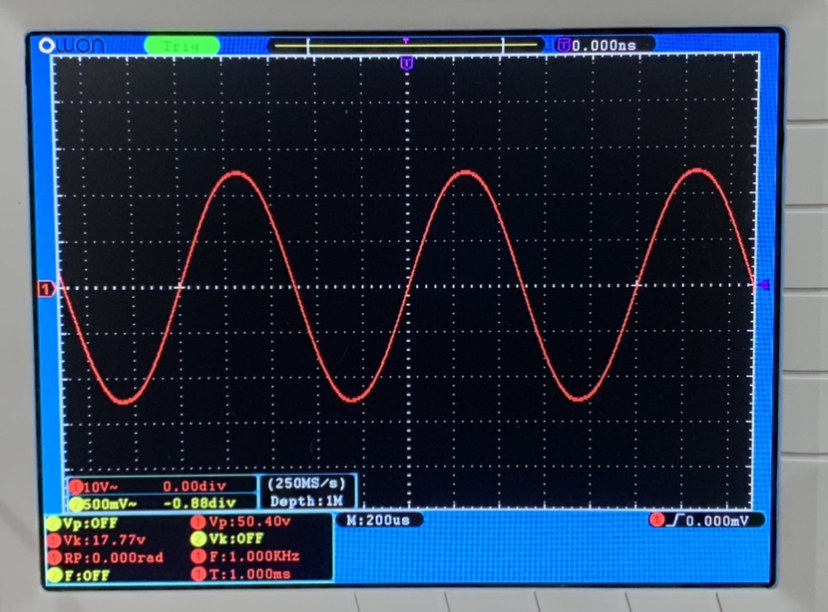
In the photo of setup and you can see the big green wire wound 8ohm dummy load. The 8ohm wire wound is not good for distortion measurements but adequate for max power. Fluke meter on left is Vrms of the output. Fluke meter on right is voltage across the R (0.165ohm) of the CRC, yielding 2.9A current. The smaller Fluke meter in back is the Source voltage of 1.527v setting.
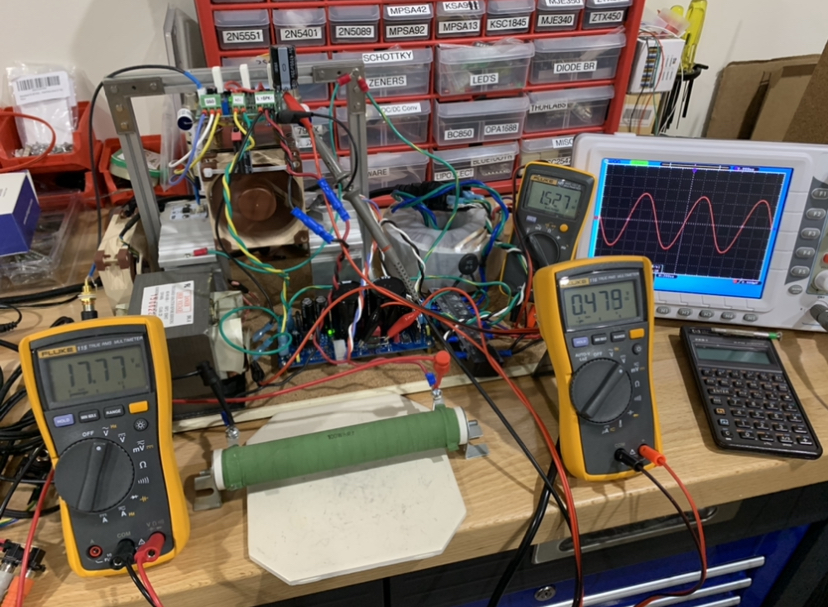
There you have it, a cheap MOT indeed has the guts to belt out the predicted 39 Watts from a LuFo amp.
I am not sure if this was what you were all waiting for - is a 39w amp with a cheap salvaged choke made from a microwave oven transformer and 28v single supply possible?
The specifics are: Vsupply of 27.3vdc, voltage as LU1014D was 1.527v, bias current was 2.90A, and Vrms according to the Fluke 116 was 17.77vrms. The Oscope shows 17.77Vrms as well. That’s 39.5wrms into 8ohms - well before clipping starts. One interesting thing to note is that backing off on the bias current to 2.9A yields better clip performance than 3.0A. Not sure why, maybe combination of voltage sag on limited voltage from time of day max voltage of 27.3v vs 28v nominal.
In the photo of setup and you can see the big green wire wound 8ohm dummy load. The 8ohm wire wound is not good for distortion measurements but adequate for max power. Fluke meter on left is Vrms of the output. Fluke meter on right is voltage across the R (0.165ohm) of the CRC, yielding 2.9A current. The smaller Fluke meter in back is the Source voltage of 1.527v setting.
There you have it, a cheap MOT indeed has the guts to belt out the predicted 39 Watts from a LuFo amp.
Attachments
Last edited:
That does look promising. Perhaps against my better judgement (yet another rare, discontinued part) I'm tempted to acquire some LU1014D and have at it. Have already acquired the MOT, and even have a pair of Hammond 195T5 stashed.
Looking at the waveform, there may be a small amount of compression setting in. Still not clipping, just some compression. The positive peaks have a different shape from the negative peaks. Probably sonically unobtrusive.
Looking at the waveform, there may be a small amount of compression setting in. Still not clipping, just some compression. The positive peaks have a different shape from the negative peaks. Probably sonically unobtrusive.
Last edited:
I’m sure you are right - if I back it off to 17.1vrms, it looks more symmetric.
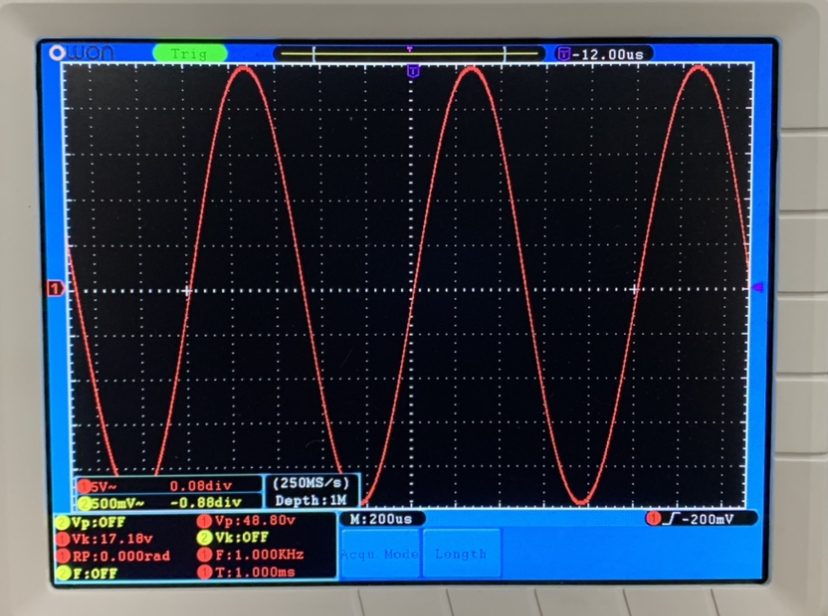
Listening to test track to see if the optimizations mattered. Yes they do! It transformed the amp - it’s quite a powerful monster now. The grip it has on the woofer cone is mind boggling - all from a SE Class A amp with a little pinned LU1014D running the show.
Test of LuFo Amp with 6.5in 2-way Reflex - YouTube
Listening to test track to see if the optimizations mattered. Yes they do! It transformed the amp - it’s quite a powerful monster now. The grip it has on the woofer cone is mind boggling - all from a SE Class A amp with a little pinned LU1014D running the show.
Test of LuFo Amp with 6.5in 2-way Reflex - YouTube
Attachments
Last edited:
Oops I meant this video.
LuFo amp with optimized preamp and bias current t for true 39.5wrms output. - YouTube
LuFo amp with optimized preamp and bias current t for true 39.5wrms output. - YouTube
X,
Great updates.
From my side, Toroidy appears to be on holiday until 6/1. So will report afterwards.
Best,
Anand.
Great updates.
From my side, Toroidy appears to be on holiday until 6/1. So will report afterwards.
Best,
Anand.
- Home
- Amplifiers
- Pass Labs
- LuFo Amp - 39w SE Class A from 28v Rail
